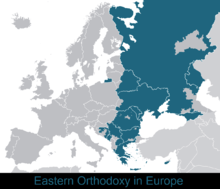Orthodox Europe

Orthodoxy in Europe
The term Orthodox Europe is used for the predominantly Eastern Orthodox countries of Eastern Europe. These include Belarus, Bulgaria, Cyprus, Georgia, Greece, Macedonia, Moldova, Montenegro, Romania, Russia, Serbia, Ukraine.
History
Almost all of Orthodox Europe fell to Communism after World War II.[1]
Orthodoxy in Orthodox majority countries
- Orthodoxy in Greece, 95% (estimation)
- Orthodoxy in Serbia, 84.6% (2011 census)
- Orthodoxy in Bulgaria, 82.6% (2001 census)
- Orthodoxy in Montenegro, 72.1% (2011 census)
- Orthodoxy in Estonia, 16.15% (2011 census)
Orthodoxy in non-Orthodox majority countries
- Orthodox Christianity in Bosnia and Herzegovina, 31% (estimation)
- Orthodoxy in Croatia, 4.44% (2011 census)
- Orthodoxy in Hungary
- Eastern Orthodoxy in the Republic of Ireland
- Orthodoxy in Norway
See also
References
- ↑ Mary B. Cunningham; Elizabeth Theokritoff (18 December 2008). The Cambridge Companion to Orthodox Christian Theology. Cambridge University Press. pp. 15–. ISBN 978-0-521-86484-8.
Sources
- Victoria Clark (21 November 2011). Why Angels Fall: A Journey Through Orthodox Europe from Byzantium to Kosovo. Pan Macmillan. ISBN 978-1-4472-1639-1.
- Jonathan Shepard (2007). The Expansion of Orthodox Europe: Byzantium, the Balkans and Russia. Ashgate Variorum. ISBN 978-0-7546-5920-4.
- Jonathan Sutton; William Peter van den Bercken (2003). Orthodox Christianity and Contemporary Europe: Selected Papers of the International Conference Held at the University of Leeds, England, in June 2001. Peeters Publishers. pp. 92–. ISBN 978-90-429-1266-3.
- Alexandru Duţu (1 January 1998). Political Models and National Identities in "Orthodox Europe". Babel. ISBN 978-973-48-1042-0.
This article is issued from Wikipedia - version of the Tuesday, February 09, 2016. The text is available under the Creative Commons Attribution/Share Alike but additional terms may apply for the media files.